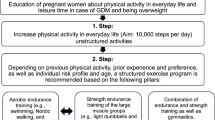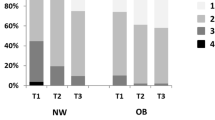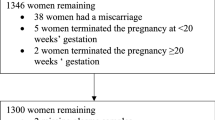Abstract
Our purpose was to review relations between physical activity during pregnancy, gestational diabetes, and other maternal metabolic markers (i.e., lipids, tumor necrosis factor alpha (TNFα), interleukin six (IL-6), leptin, and adiponectin). While observational studies indicate a protective effect of physical activity on gestational diabetes, interventions that promote recommended levels of physical activity during pregnancy (i.e., 150+ min/week) have failed to show significant effects. However, interventions have been often underpowered and with low protocol adherence. Maternal lipids, TNFα, IL-6, and leptin all increase and adiponectin decreases with a healthy pregnancy. Although the evidence base is small, preliminary results indicate a beneficial effect of physical activity on lowering triglycerides, TNFα, and leptin levels while increasing muscle-derived IL-6 levels during pregnancy. Future studies are needed to examine relationships among prospectively measured physical activity and metabolic markers throughout pregnancy, as well as theoretically based physical activity interventions to prevent gestational diabetes.

Similar content being viewed by others
References
Papers of particular interest, published recently, have been highlighted as: • Of importance •• Of major importance
Melzer K, Schutz Y, Soehnchen N, et al. Prepregnancy body mass index and resting metabolic rate during pregnancy. Ann Nutr Metab. 2010;57:221–7.
Lippi G, Albiero A, Montagnana M, et al. Lipid and lipoprotein profile in physiological pregnancy. Clin Lab. 2007;53:173–7.
Catalano PM, Huston L, Amini SB, et al. Longitudinal changes in glucose metabolism during pregnancy in obese women with normal glucose tolerance and gestational diabetes mellitus. Am J Obstet Gynecol. 1999;180:903–16.
Atienza AA, Moser RP, Perna F, et al. Self-reported and objectively measured activity related to biomarkers using NHANES. Med Sci Sports Exerc. 2011;43:815–21.
Panagiotakos DB, Pitsavos C, Chrysohoou C, et al. The associations between leisure-time physical activity and inflammatory and coagulation markers related to cardiovascular disease: the Attica study. Prev Med. 2005;40:432–7.
Bouassida A, Zalleg D, Bouassida S, et al. Leptin, its implication in physical exercise and training: a short review. J Sports Sci Med. 2006;5:172–81.
Sternfeld B. Physical activity and pregnancy outcome. Review and recommendations. Sports Med. 1997;23:33–47.
American College of Obstetricians and Gynecologists. Exercise during pregnancy and the postpartum period. Committee Opinion Number 267. ACOG Int J Gynaecol Obstet. 2002;77:79–81.
U.S. Department of Health and Human Services. U.S. physical activity guidelines for Americans. [cited 2014 Aug 6]. Available from: http://www.health.gov/paguidelines: ODPHP Publication No. U0036; 2008.
Evenson K, Barakat R, Brown W, et al. Guidelines for physical activity during pregnancy: comparisons from around the world. Am J Lifestyle Med. 2014;8:102–21. This paper provides a summary of physical activity guidelines during pregnancy from 9 different countries.
Evenson KR, Wen F. National trends in self-reported physical activity and sedentary behaviors among pregnant women: NHANES 1999-2006. Prev Med. 2010;50:123–8.
Bellamy L, Casas JP, Hingorani AD, et al. Type 2 diabetes mellitus after gestational diabetes: a systematic review and meta-analysis. Lancet. 2009;373:1773–9.
Ehrenberg HM, Mercer BM, Catalano PM. The influence of obesity and diabetes on the prevalence of macrosomia. Am J Obstet Gynecol. 2004;191:964–8.
Oken E, Taveras EM, Kleinman KP, et al. Gestational weight gain and child adiposity at age 3 years. Am J Obstet Gynecol. 2007;196:322. e321-328.
Catalano PM, Ehrenberg HM. The short- and long-term implications of maternal obesity on the mother and her offspring. BJOG. 2006;113:1126–33.
Torloni MR, Betran AP, Horta BL, et al. Prepregnancy BMI and the risk of gestational diabetes: a systematic review of the literature with meta-analysis. Obes Rev. 2009;10:194–203.
Jiwani A, Marseille E, Lohse N, et al. Gestational diabetes mellitus: results from a survey of country prevalence and practices. J Matern Fetal Neonatal Med. 2012;25:600–10.
Wendland EM, Torloni MR, Falavigna M, et al. Gestational diabetes and pregnancy outcomes—a systematic review of the World Health Organization (WHO) and the International Association of Diabetes in Pregnancy Study Groups (IADPSG) diagnostic criteria. BMC Pregnancy Childbirth. 2012;12:23. This article provides an overview of current diagnostic criteria for gestational diabetes and their relation to birth outcomes.
Tobias DK, Zhang C, van Dam RM, et al. Physical activity before and during pregnancy and risk of gestational diabetes mellitus: a meta-analysis. Diabetes Care. 2011;34:223–9.
Morkrid K, Jenum AK, Berntsen S, et al. Objectively recorded physical activity and the association with gestational diabetes. Scand J Med Sci Sports. 2014. doi:10.1111/sms.12183. This population-based prospective study examined the relation between objectively measured physical activity in early gestation (<20 weeks) and odds of gestational diabetes. This is a significant improvement over previous studies that have relied on self-reported measures of physical activity.
Yin YN, Li XL, Tao TJ, et al. Physical activity during pregnancy and the risk of gestational diabetes mellitus: a systematic review and meta-analysis of randomised controlled trials. Br J Sports Med. 2014;48:290–5.
Ruchat SM, Mottola MF. The important role of physical activity in the prevention and management of gestational diabetes mellitus. Diabetes Metab Res Rev. 2013;29:334–46. This review emphasizes low compliance as a reason why exercise intervention studies have failed to show a reduced risk of gestational diabetes.
Leppanen M, Aittasalo M, Raitanen J, et al. Physical activity during pregnancy: predictors of change, perceived support and barriers among women at increased risk of gestational diabetes. Matern Child Health J. 2014;18(9):2158–66.
Davenport MH, Mottola MF, McManus R, et al. A walking intervention improves capillary glucose control in women with gestational diabetes mellitus: a pilot study. Appl Physiol Nutr Metab. 2008;33:511–7.
Mudd LM, Owe KM, Mottola MF, et al. Health benefits of physical activity during pregnancy: an international perspective. Med Sci Sports Exerc. 2013;45:268–77.
Thangaratinam S, Rogozinska E, Jolly K, et al. Effects of interventions in pregnancy on maternal weight and obstetric outcomes: meta-analysis of randomised evidence. BMJ. 2012;344:e2088–103.
Goodyear LJ, Kahn BB. Exercise, glucose transport, and insulin sensitivity. Annu Rev Med. 1998;49:235–61.
Golbidi S, Laher I. Potential mechanisms of exercise in gestational diabetes. J Nutr Metab. 2013;2013:285948. This article provides a good overview of maternal metabolic cytokines and hormones in relation to risk of gestational diabetes.
Chasan-Taber L. Gestational diabetes: is it preventable? Am J Life Med. 2012;6:395–406.
Halperin IJ, Feig DS. The role of lifestyle interventions in the prevention of gestational diabetes. Curr Diab Rep. 2014;14:452.
Mudd LM, Holzman CB, Catov JM, et al. Maternal lipids at mid-pregnancy and the risk of preterm delivery. Acta Obstet Gynecol Scand. 2012;91:726–35.
Clausen T, Burski TK, Oyen N, et al. Maternal anthropometric and metabolic factors in the first half of pregnancy and risk of neonatal macrosomia in term pregnancies. A prospective study. Eur J Endocrinol. 2005;153:887–94.
Son GH, Kwon JY, Kim YH, et al. Maternal serum triglycerides as predictive factors for large-for-gestational age newborns in women with gestational diabetes mellitus. Acta Obstet Gynecol Scand. 2010;89:700–4.
Kulkarni SR, Kumaran K, Rao SR, et al. Maternal lipids are as important as glucose for fetal growth: findings from the PUNE maternal nutrition study. Diabetes Care. 2013;36:2706–13.
Butler CL, Williams MA, Sorensen TK, et al. Relation between maternal recreational physical activity and plasma lipids in early pregnancy. Am J Epidemiol. 2004;160:350–9.
Schreuder YJ, Hutten BA, van Eijsden M, et al. Ethnic differences in maternal total cholesterol and triglyceride levels during pregnancy: the contribution of demographics, behavioural factors and clinical characteristics. Eur J Clin Nutr. 2011;65:580–9.
Loprinzi PD, Fitzgerald EM, Woekel E, et al. Association of physical activity and sedentary behavior with biological markers among U.S. Pregnant women. J Womens Health. 2013;22:953–8. This study utilizes data from NHANES to examine relations between physical activity during pregnancy and concurrently measured metabolic markers.
van Poppel MN, Oostdam N, Eekhoff ME, et al. Longitudinal relationship of physical activity with insulin sensitivity in overweight and obese pregnant women. J Clin Endocrinol Metab. 2013;98:2929–35.
Bo S, Rosato R, Ciccone G, et al. Simple lifestyle recommendations and the outcomes of gestational diabetes. A 2x2 factorial randomized trial. Diabetes Obes Metab. 2014. doi:10.1111/dom.12289.
Ko CW, Napolitano PG, Lee SP, et al. Physical activity, maternal metabolic measures, and the incidence of gallbladder sludge or stones during pregnancy: a randomized trial. Am J Perinatol. 2014;31:39–48.
Clapp 3rd JF, Kiess W. Effects of pregnancy and exercise on concentrations of the metabolic markers tumor necrosis factor alpha and leptin. Am J Obstet Gynecol. 2000;182:300–6.
van Poppel MN, Peinhaupt M, Eekhoff ME, et al. Physical activity in overweight and obese pregnant women is associated with higher levels of proinflammatory cytokines and with reduced insulin response through interleukin-6. Diabetes Care. 2014;37:1132–9.
Williams MA, Qiu C, Muy-Rivera M, et al. Plasma adiponectin concentrations in early pregnancy and subsequent risk of gestational diabetes mellitus. J Clin Endocrinol Metab. 2004;89:2306–11.
Ning Y, Williams MA, Butler CL, et al. Maternal recreational physical activity is associated with plasma leptin concentrations in early pregnancy. Hum Reprod. 2005;20:382–9.
Hopkins SA, Baldi JC, Cutfield WS, et al. Effects of exercise training on maternal hormonal changes in pregnancy. Clin Endocrinol. 2011;74:495–500.
Briley AL, Barr S, Badger S, et al. A complex intervention to improve pregnancy outcome in obese women; the UPBEAT randomised controlled trial. BMC Pregnancy Childbirth. 2014;14:74–83. This article describes the methods of a behavioral intervention to reduce the incidence of gestational diabetes that is currently underway in the UK.
Jelsma JG, van Poppel MN, Galjaard S, et al. DALI: vitamin D and lifestyle intervention for gestational diabetes mellitus (GDM) prevention: An European multicentre, randomised trial—study protocol. BMC Pregnancy Childbirth. 2013;13:142–56. This article describes the methods of a behavioral intervention to reduce the incidence of gestational diabetes that is currently underway in Europe.
Rich-Edwards JW, Fraser A, Lawlor DA, et al. Pregnancy characteristics and women's future cardiovascular health: an underused opportunity to improve women's health? Epidemiol Rev. 2014;36:57–70.
Mosca L, Benjamin EJ, Berra K, et al. Effectiveness-based guidelines for the prevention of cardiovascular disease in women—2011 update: a guideline from the American Heart Association. Circulation. 2011;123:1243–62.
Barouki R, Gluckman PD, Grandjean P, et al. Developmental origins of non-communicable disease: implications for research and public health. Environ Health. 2012;11:42.
Rasmussen KM, Kjolhede CL. Maternal obesity: a problem for both mother and child. Obesity. 2008;16:929–31.
Hure AJ, Collins CE, Giles WB, et al. Protocol for the women and their children's health (WATCH) study: a cohort of pregnancy and beyond. J Epidemiol. 2012;22:267–75.
Compliance with Ethics Guidelines
Conflict of Interest
Lanay M. Mudd and Kelly R. Evenson declare that they have no conflict of interest.
Human and Animal Rights and Informed Consent
This article does not contain any studies with human or animal subjects performed by any of the authors.
Author information
Authors and Affiliations
Corresponding author
Additional information
This article is part of the Topical Collection on Diabetes and Pregnancy
Rights and permissions
About this article
Cite this article
Mudd, L.M., Evenson, K.R. Review of Impacts of Physical Activity on Maternal Metabolic Health During Pregnancy. Curr Diab Rep 15, 6 (2015). https://doi.org/10.1007/s11892-014-0572-3
Published:
DOI: https://doi.org/10.1007/s11892-014-0572-3




